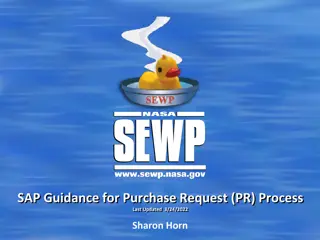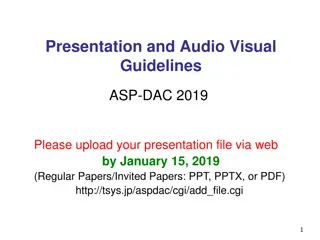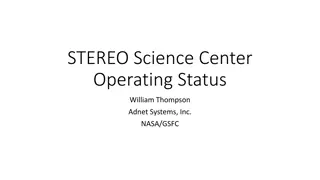Comparison of Aqua and SeaWiFS Rrs Data Error Analysis Using MOBY Data
An error analysis was conducted on Aqua and SeaWiFS Rrs data using matchup data sets classified into Optical Water Types (OWT). The analysis compared results of OWT classification using MOBY data versus satellite data, highlighting differences in error metrics such as RMSE and Bias. Aqua and SeaWiFS matchup data were sorted based on Rrs sources (MOBY and Satellite) with variations in OWT assignments. Various statistics, including bias and RMS, were computed for each sorting, showing significant changes in some cases. The study provides insights into the impact of using MOBY data for OWT classification in error analysis processes.
Download Presentation

Please find below an Image/Link to download the presentation.
The content on the website is provided AS IS for your information and personal use only. It may not be sold, licensed, or shared on other websites without obtaining consent from the author.If you encounter any issues during the download, it is possible that the publisher has removed the file from their server.
You are allowed to download the files provided on this website for personal or commercial use, subject to the condition that they are used lawfully. All files are the property of their respective owners.
The content on the website is provided AS IS for your information and personal use only. It may not be sold, licensed, or shared on other websites without obtaining consent from the author.
E N D
Presentation Transcript
We have conducted an error analysis of Aqua and SeaWiFS Rrs data using matchup data sets (Moore et al. 2014). The data sets were classified into Optical Water Types (OWT) based on the satellite Rrs data, and error metrics (RMSE and Bias) were calculated for each OWT. The matchup data sets for oligotrophic waters (OWTs 1 and 2) were predominantly MOBY matchups. Since the MOBY spectra are complete (i.e., have no missing bands), it is possible to classify matchups using MOBY instead of satellite Rrs spectra. This powerpoint compares results of the error analysis using MOBY data for OWT classification vs. the one using satellite data. Tim Moore and Janet Campbell April 2014
Matchup Analysis at MOBY Matchup data were sorted into OWTs based on two Rrs sources: MOBY and Satellite. This resulted in a few instances with different OWT assignments depending on Rrs source. This approach provides a way to highlight cases for further analysis to understand differences. The uncertainty statistics (RMS and Bias) were computed for each sorting. Certain statistics notably the bias changed substantially. Other statistics notably the RMS changed only slightly, and a zigzag patttern in the bias remained.
Aqua RMSE OWT Sat. MOBY 1 2 sr-1 3 Avg. Classification is based on dominant OWT from satellite (solid) and MOBY (dashed) Rrs.
Bias: Rrs (Aqua) Rrs (MOBY) sr-1 OWT Sat. MOBY 1 2 3 Avg. Classification is based on dominant OWT from satellite (solid) and MOBY (dashed) Rrs.
Aqua matchup sorting Aqua classifications MOBY classifications OWT 1 2 3 Total 1 257 37 1 295 2 16 36 3 55 3 0 0 0 0 Total 273 73 4 350
Aqua Matchup spectra when MOBY=OWT 1 & Sat = OWT 2 Aqua MOBY N=38 Rrs(0+) Wavelength
SeaWiFS RMS at MOBY OWT Sat. MOBY 1 2 3 Avg.
Bias: Rrs (SeaWiFS) Rrs (MOBY) OWT Sat. MOBY 1 2 3 Avg.
SeaWiFS matchup sorting SeaWiFS classifications MOBY classifications OWT 1 2 3 Total 1 515 85 0 600 2 20 62 1 83 3 0 0 2 2 Total 535 147 3 685
OWT 2 subset analysis BIAS SeaWiFS Rrs 412 MOBY Rrs 412 OWT 2 Classification common MOBY only SeaWiFS only
SeaWiFS-MOBY OWT 2 MOBY Rrs classification Satellite Rrs classification SeaWiFS Rrs 412 443 490 510 555 670 MOBY Rrs MOBY Rrs
Preliminary Conclusions Error metrics (RMS and bias) vary depending on how the data are sorted. Bias shows the largest differences in both Aqua and SeaWiFS. A curious zigzag pattern from blue to green is present in the bias regardless of how the data are sorted. The OWT classification provides a way to highlight matchups that have significant differences. When matchups are assigned to different OWTs, this signifies a rather large difference in Rrs spectra that would merit further examination.























